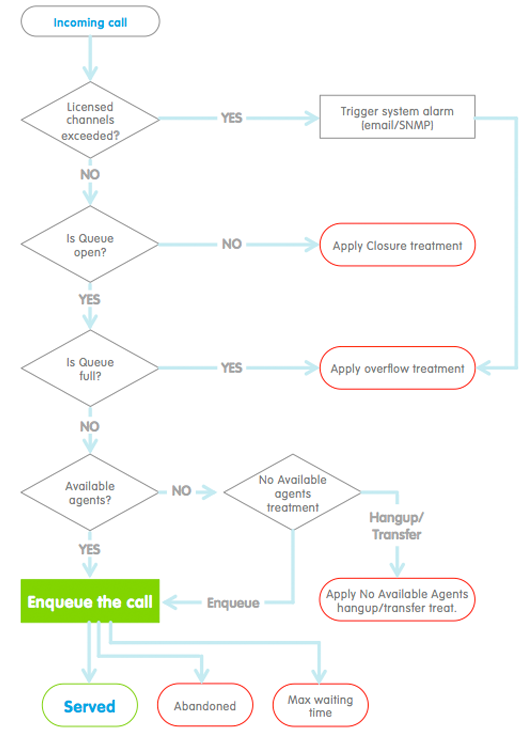Default global queue settings
Default Settings configuration
Advanced Queuing Default settings can be configured from Imagicle web portal, selecting Advanced Queuing ⇒ Default Settings.
This page, organized like a regular queue settings page, allows to define the default settings inherited in all the queues.
Changing a setting value in this page will impact on all queues that are inheriting such setting (all the queues that do not override those settings).
Below a list of most important settings you can tweak, split by tab:
Queue setting
Global Login/Logout number: this is a login/logout toggle number that allows the agent to login/logout on all own queues. This is useful if an agent is serving multiple queues, to toggle own login/logout status on all queues simultaneously. Notice that this phone number must be reachable through a route in the Calling Platform.
Delete data older than: This is the retention period (in days) to keep CDRs related to queued calls. Set this parameter to 0 to keep CDRs for an unlimited time.
Maximum waiting time: Maximum waiting time you wish to keep the caller party waiting for first available agent. Set this parameter to 0 for unlimited waiting time (not suggested!)
Behaviours tuning: Within this menu, you can find different overflow options for no available agents, no queue resources and maximum wait time reached. Each overflow option can be set to play a message and drop or play message and transfer to an internal or external phone number or extension.
Time Table
Within this tab, you can configure a common time table for standard week days + holidays. Moreover, you can also decide to force all queues closed or open, and apply relevant behaviour for day time and night time service
Voice messages
This tab allows to customize common voice prompts to be included in all your queues. Multiple voice prompts can be uploaded from this interface, as standard MP3 or WAV audio files. You can also set voice prompts as interruptable or enable queue position announcement at a chosen interval.
Call Distribution
These parameters are useful to tune the way Imagicle Advanced Queuing tries to engage operators to serve queued calls:
Enable Sticky Agent: Check this option to enable Sticky Agent feature, allowing the distribution algorithm (except on-demand) to attempt the call transfer to the last agent who served the calling contact.
Agent Stickiness duration: defines how many hours an agent is bound to a calling contact and a FIFO queue, starting from their last call.
Sticky Agent booking timeout: If above flag is checked, this parameter dictates the maximum waiting time in seconds for transferring the call to the Sticky Agent. If the timeout is reached and Sticky Agent is still unavailable, the algorithm skips to next available agent.
No answer timeout: to ring an operator for nn seconds before skipping to next one
Automatic logout agent: If enabled, agent is automatically logged out upon no answer
Max consultation calls per agent: This parameter dictates the number of calls that might be dispatched to each operator. Keep this value to 1, if you don't want to dispatch a call to a busy operator. A higher value can be useful for operators without Attendant Console, to show them additional waiting calls on IP Phone display.
After call - Wrap-up time: If you wish to give some relief to an operator who just served a call, you can set wrap-up time to a value in seconds. This is the interval where operator is not engaged by further queued calls, to allow admin tasks or CRM updates.
Decision tree
When a call is queued, Advanced Queuing evaluates a set of conditions in order to understand which is the right treatment to apply to the call.
Basically, it has to check if it has available resources (licensed channels) to manage the new call, understand the treatment scheduled for the current date/time and check if particular scenarios occur (overflow, no agents available, etc.).
The following schema depicts the decision tree that is evaluated by Advanced Queuing when a new call arrives to a queue number and the possible treatments that could be applied.
Once a call is enqueued for an agent, it can be:
SERVED: answered by an agent
ABANDONED: disconnected by the caller while waiting
TERMINATED: dropped by the system because of time out (maximum waiting time)

